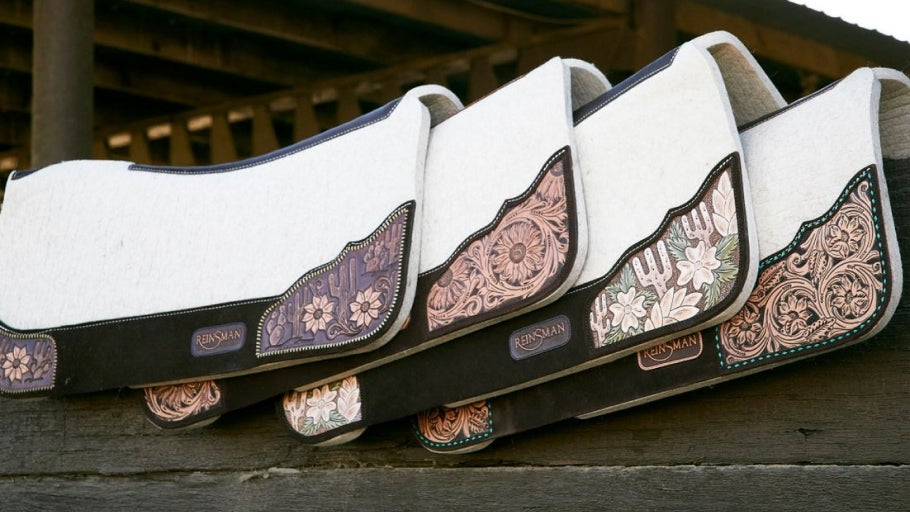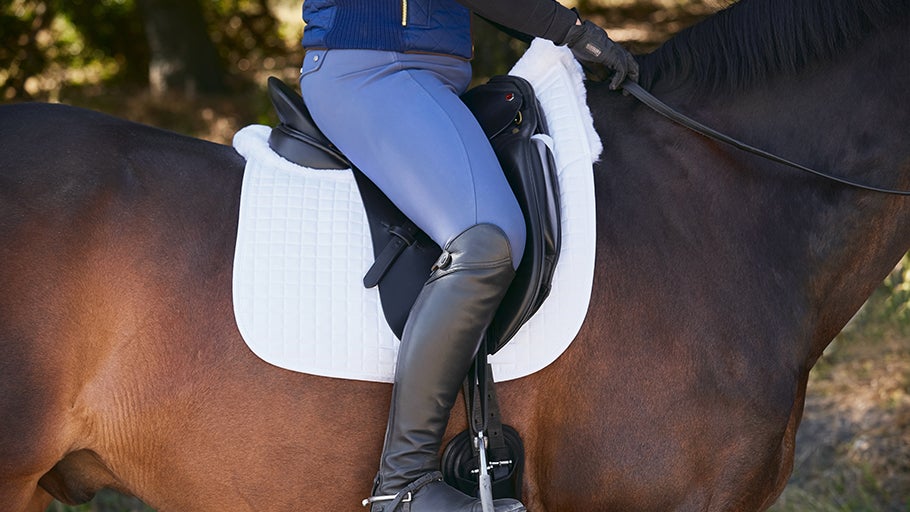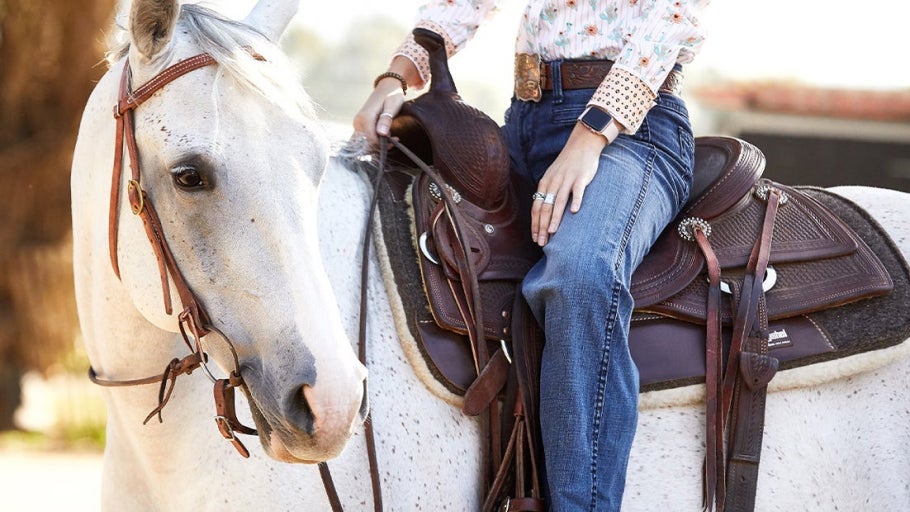
How to Clean Saddle Pads
Saddle pads are strategically designed to protect your saddle while providing support to your horse. Because they are laid directly against the horse's back time and time again, saddle pads experience a beating, being continuously exposed to sweat, dirt, and hair.
Caring for your saddle pads is an important part of tack maintenance, as it helps lengthen their lifespan for continued use. It is also important to wash your saddle pads for your horse's comfort; too much grime and build-up can lead to bacterial infections like rain rot, or cause uncomfortable rubbing on your horse. Your saddle pad needs to be able to breathe.
Below, our crew addresses commonly asked questions about saddle pad cleaning; from washing methods to drying methods to caring for the varying saddle pad materials. We will also address how to store saddle pads and offer some additional tips and tricks for special considerations. Keep reading to learn more!
Saddle Pad Washing Methods
When you determine your saddle pad needs cleaning, you'll want to start by brushing out as much debris as possible. We highly recommend a soft rubber brush like the Haas Essentials Express Hair Removal Brush or StripHair Gentle Groomer, as these are universally gentle on all saddle pad materials. Go around the top and underside of the saddle pad in circular motions, like you are brushing a horse; do not use so much pressure as to cause damage. You could even take things a step further by using a small vacuum to remove more horse hair and dirt. You can repeat this same process again after washing if necessary, since any remaining debris will have loosened up.
When washing, always use a pH-neutral soap to avoid weakening the saddle pad and irritating your horse. Thick felt and blanket-style saddle pads are typically washed with water only to prevent soap from becoming embedded deep within the saddle pad fibers. Follow the cleaning instructions provided by the manufacturer, especially for specialty saddle pads (such as those made of leather or sheepskin). There are a variety of ways riders might wash their saddle pads:
Hand Washing
When it comes to saddle pads, hand washing consists of just using a typical garden hose. Hand washing is easier with a hose nozzle attachment, so you can change the water pressure. Some saddle pad materials, like neoprene, do not hold up well to high water pressure. We advise doing a pre-soak on appropriate saddle pads with the 5 Star Equine Saddle Pad Cleaner & Soak.
If your saddle pad is particularly dirty, a longer soap soak for a few hours or overnight in a container is beneficial. You could even use the bathtub if you dare! Doing this helps get a greater amount of the dirt and sweat out of your saddle pad, plus it makes rinsing easier (and not to mention, more satisfying). Be sure to spend the time rinsing out all of the dirty soap in an outward direction until you see the water run clear. Your horse's back will thank you! Note that the saddle pad will become quite heavy when wet, so handle with care.
Pressure Washing
Pressure washers really take the work out of saddle pad cleaning. Whether it's a hand pressure washer or one at the car wash, exercise caution by standing a good distance away in order to prevent damaging your saddle pad. Please reference our chart further down to learn which saddle pad materials you should avoid cleaning with a pressure washer.
However, safely using a pressure washer on your saddle pad facilitates a more effective cleaning experience by better removing stubborn dirt and stains. Do not aim the hose directly down, but instead spray at an angle toward the edges of the pad. If you want an even deeper clean, following the same suggestion of a pre-soak makes pressure washing that much more pleasant. This cleaning method is great if you have a large number of saddle pads to wash.
Washing Machine
Our favorite saddle pad cleaning method is to use a washing machine because it is so easy! Get as much grime as you can off your saddle pads before throwing them in the wash. Take note that not all saddle pads can be machine washed; nor should they be washed in a top-load washing machine with an agitator. Saddle pads are much less prone to being damaged in a front-load washing machine. Using a laundry bag that can be tied shut helps keep the horse hair contained—it is no fun having to vacuum your washing machine after saddle pad cleaning!
Always follow the manufacturer's washing instructions; however, wash in cold water on a gentle cycle if you are unsure (again, with a pH-neutral soap). Depending on the types of saddle pads you are washing, you may be limited to washing only one at a time. If washing several saddle pads at the same time, we encourage you to run two rinse cycles. Do not overload the washing machine; this can lead to insufficient cleaning and could damage your washing machine.
Saddle Pad Drying Methods
It is imperative for your saddle pad to fully dry after work and after washing. Some saddle pad materials, such as wool and felt, typically take longer to dry compared to thinner, less dense materials. A still-wet saddle pad that then goes on your horse's back for a ride will cause uncomfortable friction. Imagine it like riding in wet pants—no thank you! Below, we cover two methods for drying your saddle pads after washing:
Air Dry
Air drying is a reliable method, especially if you are unsure whether your saddle pad should or should not go in the dryer. Though you might be tempted to air dry your pads in the sun to speed up the drying process, please refrain from doing so on particularly hot days! The more intense the UV rays, the more the sun can fade materials and cause stiffness or shrinking. It is a safer bet to dry your saddle pad in a well-ventilated area, either inside or outside, depending on the weather.
Cold temperatures and humid climates slow the drying rate; using a fan on your saddle pad to increase air circulation will help. Air dry on a rack or rail that exposes the underside and topside of the saddle pad to air flow for even drying, or vertically hang the saddle pad by the gullet hole (if it has one). More delicate saddle pads, like sheepskin ones, should be air dried away from sunlight or direct heat.
Dryer
The dryer is a great method for pliable saddle pads that do not have leather-reinforced pieces. Dry with cool or cold temperatures on the delicate setting (sometimes called the air dry setting), as hot temps can damage your saddle pad and shorten its lifespan. The dryer can also cause certain saddle pad materials to shrink or become lumpy. Do not overload the dryer or throw in a super thick saddle pad! If your saddle pad is safe to machine wash, you may assume it is also safe to dry in the dryer; however, some saddle pads can be washed but not dried. When in doubt, stick with air drying! Consult the manufacturer's care instructions to determine whether your saddle pad can or cannot be dried in the dryer.
Cleaning Saddle Pads by Material
How to care for your saddle pad is largely dependent upon its materials. If your saddle pad has leather reinforcements, the leather also needs to be cleaned and conditioned. If your saddle pad is made from genuine sheepskin, use a sheepskin-safe soap to prevent compromising the hide. As outlined below, you can see that certain saddle pad materials require a little extra care. To help keep things more clear, please reference our saddle pad cleaning chart as a general guideline. We cannot reiterate this enough: Always double-check the manufacturer's specific instructions!
| Material | Wash Method | Dry Method |
| Wool | Hand Wash, Washing Machine | Air Dry or Dryer |
| Sheepskin | Hand Wash, Washing Machine | Air Dry |
| Felt | Hand Wash, Pressure Washer | Air Dry |
| Fleece | Hand Wash, Pressure Washer, Washing Machine | Air Dry or Dryer |
| Cotton | Hand Wash, Pressure Washer, Washing Machine | Air Dry or Dryer |
| Synthetics (Suede, Neoprene, Acrylic) | Hand Wash | Air Dry |
Storing Saddle Pads
Proper storage of your saddle pads will lessen the likelihood of mold, mildew, and bad odors. Once dry after riding or cleaning, keep your saddle pads in a well-ventilated area. We advise not permanently storing your saddle pads in hot, air-tight spaces, such as the tack room in your horse trailer. Saddle pads need to be able to breathe, so we do not suggest placing anything else (like a saddle or another pad) on top of them; you do not want to obstruct the drying or breathing process. Please do not put a wet saddle pad in an enclosed bag either! Keep your saddle pad on a rail, rack, or bar that offers air flow. This will help your saddle pad release moisture after riding or washing. Once the saddle pad is completely dry, you can insert it into a protective case for long-term storage.
Cleaning Tips & Tricks
White Saddle Pads
In our experience, OxiClean is the best at removing stains from the top of your white saddle pads. Apply generously and allow the OxiClean to soak in for a while before hand washing your saddle pad or throwing it in the washing machine. We do not suggest spraying OxiClean on the underside of your white saddle pads, as the chemicals could irritate sensitive horses, even after washing. Baking soda is a more natural option that is great at brightening white saddle pads while deodorizing as well. Add a half cup of baking soda to 5 gallons of warm water in a bucket or tub to soak, or sprinkle a bit into a washing machine load.
Saddle Pad Rotation
How often you decide to clean your saddle pad is dependent on the intensity of your riding and how much your horse sweats and sheds. After each ride, allow your saddle pad to air dry. If your saddle pads do not get a chance to dry between rides or washings, they can harbor harmful bacteria that cause bad odors and potential skin issues for your horse, or even cause the saddle pad to start to mold and disintegrate. We suggest having at least two saddle pads on hand for rotational use (especially if you do daily riding or live in a humid environment). Sometimes it can take days for a thicker saddle pad to fully dry!
Cleaning Inserts/Shims
First, allow your saddle pad to fully dry after a ride. Remove the inserts from your pad and prepare a soaking solution in a tub. We have found that a ratio of about a half cup of baking soda or vinegar to 5 gallons of warm water is the most ideal. Baking soda will gently clean while removing odors. Vinegar will dissolve sweat and detoxify as well. Do not use soap or bleach on your inserts/shims, as these solutions are typically too harsh. Or, you could skip soaking altogether and simply rinse your shims with plain water!
Drain the soak and rinse your inserts, then remove as much moisture as possible by pressing or stepping on the inserts. Do not roll, wring, or twist! Lay your shims flat down on a towel, then place another towel on top. Remove any excess water. Finish by laying your inserts flat down again, but on a clean, dry towel. Allow them to fully air dry away from direct heat or sunlight before returning to your saddle pad.
Closing Thoughts
Once you understand the basics of saddle pad washing, drying, and storing, you can lengthen the lifespan of your saddle pads—keeping both you and your horse happy! We hope this training guide has helped shed some light (and horse hair) on how to clean your own saddle pads, or has at least given you a heads-up on the care required for a new saddle pad you might be considering. If you have any lingering curiosities or more specific questions, please feel free to contact our friendly customer service team at 1(800)620-9145 or info@ridingwarehouse.com for help; we will do our best to find a saddle pad solution for you!
Related Articles





















